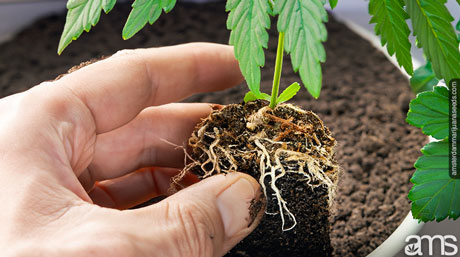Open Soil Vs Plant Pots
Introduction:
Cannabis cultivation has gained considerable attention in recent years, thanks to its increasing legalization and therapeutic potential. While many growers focus on lighting, nutrients, and watering techniques, the significance of the root system is often overlooked. The root system plays a crucial role in supporting the plant’s overall health, growth, and nutrient absorption. In this article, we will explore the root system of the pot plant and delve into the differences between growing in open soil versus using various types of plant pots, such as large pots, small pots, round pots, square pots, and even felt pots.
Understanding the Cannabis Root System:
The root system of the marijuana plant is a complex and intricate network that plays a fundamental role in its growth and overall well-being. A deeper understanding of the root system can help growers optimize cultivation practices and achieve healthier and more productive plants.
The taproot system of cannabis consists of a central main root known as the taproot, which grows vertically downward into the soil. From the taproot, numerous lateral roots branch out horizontally, extending and exploring the surrounding soil. These lateral roots form a dense fibrous network, which is responsible for water and nutrient absorption.

One key advantage of the taproot system is its ability to reach deeper into the soil profile, accessing nutrients and moisture sources that may not be readily available to plants with shallower root systems. The taproot acts as an anchor, providing stability to the plant and allowing it to withstand environmental stressors such as wind and heavy rainfall.
Open Soil Cultivation:
Growing cannabis directly in open soil offers several advantages for the development of a robust root system. In open soil, weed plants have the freedom to spread their roots as far as they need to, enabling the establishment of a strong foundation and maximizing nutrient absorption.
One of the primary benefits of open soil cultivation is the ability of the roots to explore a larger volume of soil. This exploration leads to increased access to essential nutrients and water sources, resulting in improved overall plant health. The plants can tap into deeper layers of soil, where vital nutrients may be more abundant.
Furthermore, open soil provides excellent drainage properties, allowing excess water to escape easily. Proper drainage prevents waterlogging, which can suffocate the roots and lead to root rot. The presence of oxygen in the soil is crucial for root respiration, and open soil allows for better aeration, promoting healthy root development.
In open soil, beneficial soil microbes and organisms play a vital role in the breakdown of organic matter, releasing nutrients in a form that plants can readily absorb. These microbes contribute to the creation of a healthy soil ecosystem, fostering symbiotic relationships with the roots and enhancing nutrient availability.
Additionally, open soil cultivation allows for a more natural expression of the cannabis plant’s genetic potential. The unrestricted growth of roots provides the plant with the space it needs to develop to its fullest. This can result in potentially higher yields and improved terpene profiles, as the plant is able to fully express its genetic traits without the constraints of container cultivation.
It is important to note that open soil cultivation requires careful consideration of the soil composition and preparation. Proper soil testing and amendment can ensure that the necessary nutrients are available in the soil to support healthy root development. Organic matter, such as compost or well-rotted manure, can be incorporated into the soil to enhance its fertility and structure.
Overall, open soil cultivation offers numerous benefits for cannabis plants, particularly when it comes to root system development. The ability of the roots to explore a larger volume of soil, access deeper nutrient sources, and interact with beneficial soil organisms contributes to overall plant health and productivity. By providing an optimal growing environment through open soil cultivation, growers can lay the foundation for thriving marijuana plants.
Plant Pot Cultivation:
While open soil cultivation offers several advantages, growing cannabis in plant pots has gained popularity due to its versatility and ease of management. Let’s explore the differences between large pots, small pots, round pots, square pots, and even felt pots:
- Large Pots: Large pots provide ample space for the roots to spread, allowing for better nutrient absorption and overall plant health. The increased soil volume helps maintain stability and reduces the risk of nutrient deficiencies or waterlogging. It is particularly beneficial for larger cannabis varieties with extensive root systems. The larger size of these pots also offers more room for organic matter, such as compost or beneficial microbes, which can enhance soil fertility and promote healthy root development. Furthermore, large pots provide a buffer against rapid changes in environmental conditions, such as temperature fluctuations, ensuring a more stable growing environment for weed plants.
- Small Pots: Small pots are suitable for limited growing spaces and indoor cultivation. However, they restrict root expansion and may necessitate more frequent watering and nutrient supplementation. The limited soil volume can lead to stunted growth and hinder the plant’s ability to reach its full potential. To overcome these limitations, growers using small pots can employ techniques like frequent fertigation (the combination of fertilization and irrigation) to ensure the plants receive adequate nutrients. Additionally, optimizing the soil composition by adding organic matter and using well-draining substrates can improve moisture retention and nutrient availability in small pots. Careful attention to plant care and monitoring is crucial in maximizing the performance of pot plants in small pots.
- Round Pots: Round pots allow for even root distribution and encourage a more natural root growth pattern. The absence of corners eliminates the possibility of root binding, ensuring the plant can access nutrients and water evenly. The circular shape of round pots promotes a balanced distribution of lateral roots, preventing overcrowding and enhancing nutrient uptake efficiency. Additionally, round pots facilitate better airflow around the root zone, reducing the risk of excess moisture and root diseases. The uniform distribution of roots in round pots also contributes to better stability and minimizes the risk of toppling, especially when plants become top-heavy during the flowering stage.
- Square Pots: Square pots are preferred by some growers as they make efficient use of space, allowing for easy organization and maximizing the number of plants per square meter. However, they can promote root circling if not managed properly. When the roots reach the corners of square pots, they may begin to circle around the container, potentially affecting nutrient uptake and overall plant health. To mitigate this issue, growers should regularly inspect the root system and transplant the plants to larger containers when necessary. Additionally, employing techniques like root pruning by trimming the circling roots before transplanting can encourage a more outward growth pattern and prevent root-binding issues. By maintaining proper root management, square pots can be an effective option for optimizing space utilization in cannabis cultivation.
- Felt Pots: Felt pots, also known as fabric pots or smart pots, have gained popularity among marijuana cultivators. These porous containers promote air pruning, which stimulates the growth of lateral roots, prevents root circling, and encourages a more fibrous root system. The breathable fabric allows for better air exchange and oxygenation of the root zone, facilitating root respiration and nutrient uptake. The enhanced drainage offered by felt pots reduces the risk of overwatering, preventing waterlogged conditions that can lead to root rot. The fibrous nature of the fabric also acts as a natural barrier against root-bound growth, enabling healthier and more extensive root development. Moreover, felt pots can be beneficial in outdoor settings as they allow for better temperature regulation, preventing overheating of the root zone during hot weather.
Conclusion:
The root system of the weed plant is a critical element in achieving healthy and productive growth. While open soil cultivation allows for unrestricted root expansion and natural expression of genetic potential, plant pots provide flexibility, particularly in constrained spaces. Large pots offer ample room for roots to thrive, round pots promote even root distribution, square pots optimize space utilization, and felt pots encourage air pruning and better drainage. Each method has its own advantages and considerations, and growers should choose the approach that aligns with their specific circumstances, available space, and desired outcomes. Ultimately, understanding and nurturing the root system is vital to unlocking the full potential of cannabis cultivation. By providing the right conditions for root growth, growers can ensure healthy plants and maximize yield and quality.
Frequently Asked Questions
What are the advantages of open soil cultivation for cannabis plants?
Open soil cultivation offers several advantages for cannabis plants. The unrestricted growth of roots allows them to explore a larger volume of soil, access deeper nutrient sources, and interact with beneficial soil organisms. This leads to improved overall plant health, increased nutrient absorption, and potentially higher yields. Open soil also provides excellent drainage properties, prevents waterlogging, and promotes healthy root development.
What are the benefits of using large pots for cannabis cultivation?
Large pots provide ample space for the roots to spread, allowing for better nutrient absorption and overall plant health. The increased soil volume helps maintain stability and reduces the risk of nutrient deficiencies or waterlogging. Large pots also offer more room for organic matter and beneficial microbes, enhancing soil fertility and promoting healthy root development. Additionally, large pots provide a buffer against environmental fluctuations, ensuring a more stable growing environment for pot plants.
How do round pots benefit cannabis plants’ root growth?
Round pots promote even root distribution and encourage a more natural root growth pattern. The absence of corners eliminates the possibility of root binding and allows the plant to access nutrients and water evenly. The circular shape of round pots promotes a balanced distribution of lateral roots, prevents overcrowding, and enhances nutrient uptake efficiency. Round pots also facilitate better airflow around the root zone, reducing the risk of excess moisture and root diseases.



